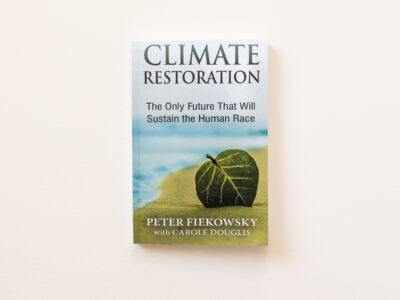It’s no longer just about net-zero carbon emissions. Now it’s about net-zero carbon emissions AND climate restoration. That’s right, our new goal is to restore our climate to CO2 levels that will allow future humans to evolve and flourish.
And we’re going to do it by 2050 — with the processes Mother Earth has been using to control the climate for millions of years.
I recently read Peter Fiekowsky’s new book, Climate Restoration: The Only Future That Will Sustain the Human Race, and I am feeling so optimistic. The global warming conversation has been filled with dread and despair for such a long time. I’ve never actually believed the dire prediction that humanity would go extinct, but I’ve never had a clear vision of how we’d save ourselves either. Now I do.
In his book, Fiekowsky lays out a plan for moving forward to a future where humanity doesn’t just survive — it thrives. The problem with net-zero carbon emissions as our only goal is this:
“Meeting the Paris [Accords] goal of net zero emissions by 2050 will see CO2 level off at about 460 parts per million. That’s more than 50 percent higher than human beings ever survived.”
What we need then is a second goal. And that’s where climate restoration comes in.
To restore the climate, in this context, is to return our atmosphere to pre-industrial CO2 levels, less than 300 parts per million, by 2050. That means we’ll have to remove roughly a trillion tons of excess CO2 from the atmosphere.
I know that sounds like an impossible task, but the way Fiekowsky describes it makes so much sense. He makes it all seem completely obvious and doable — and inevitable. I couldn’t help wondering, why haven’t we been talking about this all along?
“People often ask me why I’m so confident that we can restore the climate. I tell them, “Because it’s been done before.” Nature has removed massive amounts of carbon dioxide from the atmosphere 10 times in the last million years, and likely many more times before then.”
He focuses on four main methods of carbon removal:
- synthetic limestone manufacture
- seaweed permaculture
- ocean iron fertilization, and
- acceleration of natural methane oxidation.
Each method is based on a process that already exists in nature. And the technology needed for each is already well underway.
Of course, there is a fifth method we need to implement, but it’s not technology based: smaller family sizes. A population of 10 billion people (by 2050) using up this planet’s resources is not sustainable in the long term, as we’re finding out. The good news here is that women around the world are already choosing smaller families on their own.
“What is needed now is a collective commitment to prioritize humanity and to restore the climate and population to conditions that [will allow] us to flourish.”
In my mind, it’s like we humans are a small child throwing our toys all over the living room. Mother Earth sees us and says, “No, no, stop that right now!” That is bad behavior and you may not continue. That’s net-zero carbon emissions.
Then she says, “Now pick up all of these toys. Here, let me show you how.” You’ve made a mess and now you need to clean it up. That’s climate restoration.
With the combination of these two goals, we will have learned a valuable lesson about taking care of our home.
And created a cleaner, healthier, livable planet for the generations to come.
I’m feeling inspired and invigorated by this new conversation and will continue following the climate restoration movement. Now go read the book and see what you think.
If you prefer video, you can find a discussion with the author here. It’s hosted by the Pachamama Alliance.

 Finding Peace
Finding Peace